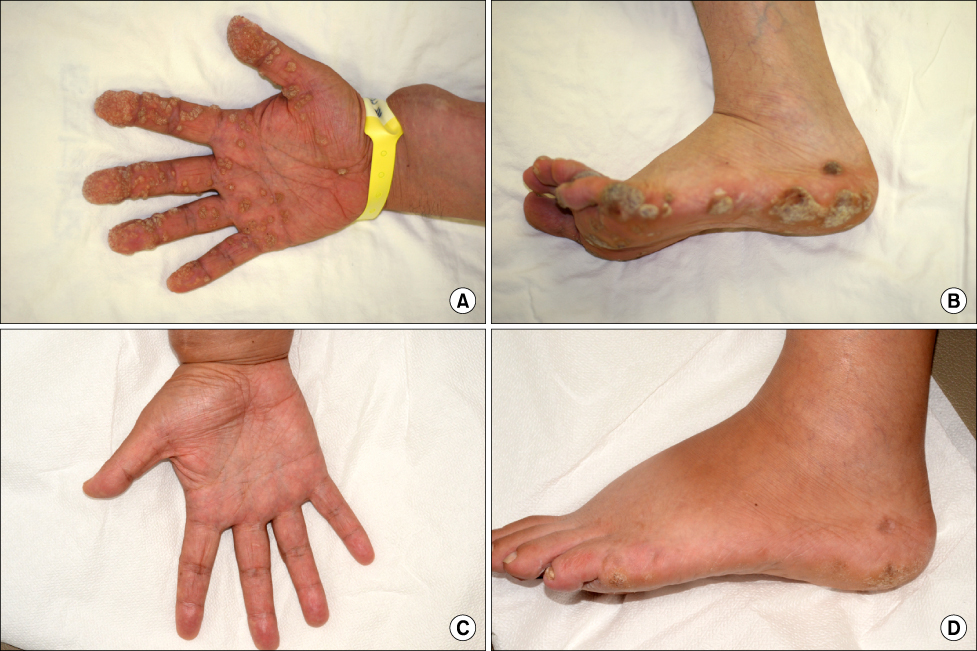J Korean Soc Transplant.
2012 Sep;26(3):207-209. 10.4285/jkstn.2012.26.3.207.
Verruca Eradication Following Conversion to Sirolimus in a Renal Transplant Recipient after Longstanding Cyclosporine A Treatment
- Affiliations
-
- 1Department of Surgery, Yonsei University Health System, Seoul, Korea. yukim@yuhs.ac
- 2Research Institute for Transplantation, Yonsei University Health System, Seoul, Korea.
- KMID: 2003537
- DOI: http://doi.org/10.4285/jkstn.2012.26.3.207
Abstract
- We present the case of a 50-year-old male kidney transplant recipient whose verruca skin warts completely disappeared after conversion of immunosuppressive treatment from cyclosporine A to sirolimus. Before conversion, the patient underwent three sessions of cryotherapy, but this treatment failed to produce noticeable improvement in wart number or severity. In this case of a transplant recipient under CsA-based immunosuppression, change of immunosuppressive treatment to sirolimus produced dramatic improvement in the elimination of verruca warts.
Keyword
MeSH Terms
Figure
Reference
-
1. Moloney FJ, Keane S, O'Kelly P, Conlon PJ, Murphy GM. The impact of skin disease following renal transplantation on quality of life. Br J Dermatol. 2005. 153:574–578.
Article2. McLelland J, Rees A, Williams G, Chu T. The incidence of immunosuppression-related skin disease in long-term transplant patients. Transplantation. 1988. 46:871–874.
Article3. Pruvost C, Penso-Assathiany D, Bachot N, Lang P, Roujeau JC. Risk factors for cutaneous wart onset in transplant recipients. Ann Dermatol Venereol. 2002. 129:291–293.4. Barba A, Tessari G, Talamini G, Chieregato GC. Analysis of risk factors for cutaneous warts in renal transplant recipients. Nephron. 1997. 77:422–426.
Article5. Marcén R. Immunosuppressive drugs in kidney transplantation: impact on patient survival, and incidence of cardiovascular disease, malignancy and infection. Drugs. 2009. 69:2227–2243.6. Hampton T. Skin cancer's ranks rise: immunosuppression to blame. JAMA. 2005. 294:1476–1480.7. Serdar ZA, Eren PA, Canbakan M, Turan K, Tellioglu G, Gülle S, et al. Dermatologic findings in renal transplant recipients: possible effects of immunosuppression regimen and p53 mutations. Transplant Proc. 2010. 42:2538–2541.
Article8. Kostaki M, Venetz JP, Nseir G, Meylan P, Sahli R, Pascual M, et al. Giant warts in a kidney transplant patient: regression with sirolimus. Br J Dermatol. 2010. 162:1148–1150.
Article9. Shahidi S, Moeinzadeh F, Mohammadi M, Gholamrezaei A. Sirolimus-based immunosuppression for treatment of cutaneous warts in kidney transplant recipients. Iran J Kidney Dis. 2011. 5:351–353.10. Dharancy S, Catteau B, Mortier L, Boleslawski E, Declerck N, Canva V, et al. Conversion to sirolimus: a useful strategy for recalcitrant cutaneous viral warts in liver transplant recipient. Liver Transpl. 2006. 12:1883–1887.
Article11. Di Benedetto F, Di Sandro S, De Ruvo N, Montalti R, Ballarin R, Guerrini GP, et al. First report on a series of HIV patients undergoing rapamycin monotherapy after liver transplantation. Transplantation. 2010. 89:733–738.
Article12. Gallego R, Henriquez F, Oliva E, Camacho R, Hernández R, Hortal L, et al. Switching to sirolimus in renal transplant recipients with hepatitis C virus: a safe option. Transplant Proc. 2009. 41:2334–2336.
Article13. Bonatti H, Aigner F, De Clercq E, Boesmueller C, Widschwendner A, Larcher C, et al. Local administration of cidofovir for human papilloma virus associated skin lesions in transplant recipients. Transpl Int. 2007. 20:238–246.
Article14. Sayin B, Karakayali H, Colak T, Sevmis S, Pehlivan S, Demirhan B, et al. Conversion to sirolimus for chronic allograft nephropathy and calcineurin inhibitor toxicity and the adverse effects of sirolimus after conversion. Transplant Proc. 2009. 41:2789–2793.
Article15. Lee HS, Huh KH, Kim YS, Kim MS, Kim HJ, Kim SI, et al. Sirolimus-induced pneumonitis after renal transplantation: a single-center experience. Transplant Proc. 2012. 44:161–163.
Article
- Full Text Links
- Actions
-
Cited
- CITED
-
- Close
- Share
- Similar articles
-
- A Case of Squamous Cell Carcinoma in Nasal Cavity Treated with Conversion to Sirolimus in a Patient with Kidney Transplantation
- A Case of Kaposi's Sarcoma Improved by Sirolimus Treatment in the Kidney Transplant Recipient
- Sirolimus-induced pneumonitis in a renal transplant recipient
- Comparison of Early and Late Conversion of Sirolimus in Experimental Model of Chronic Cyclosporine Nephropathy
- Proliferation Signal Inhibitors: Sirolimus and Everolimus


